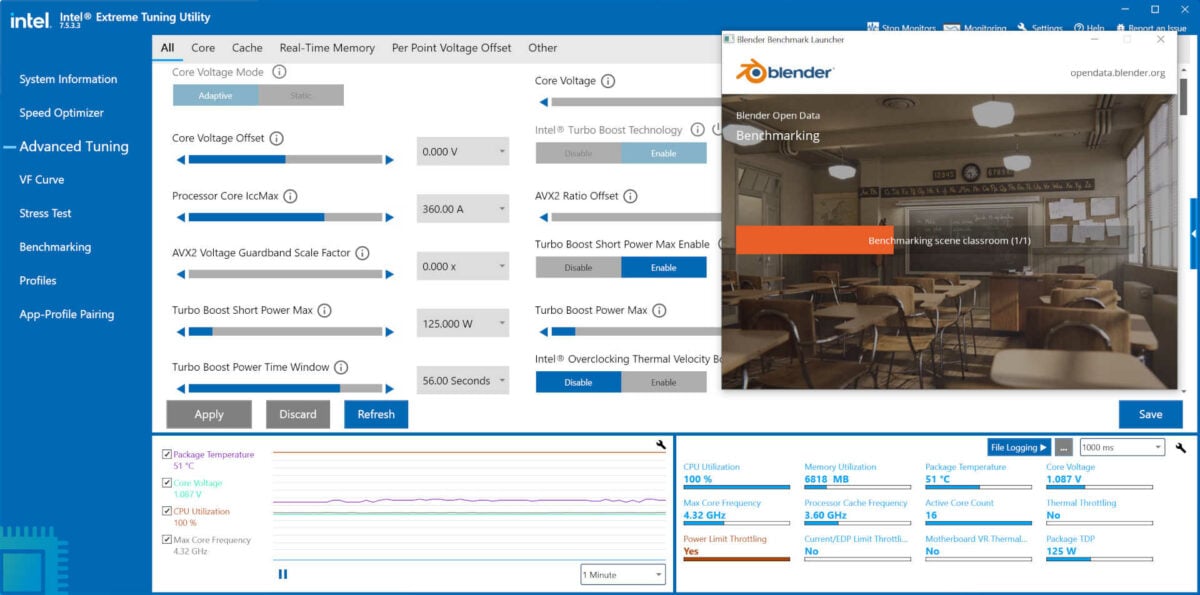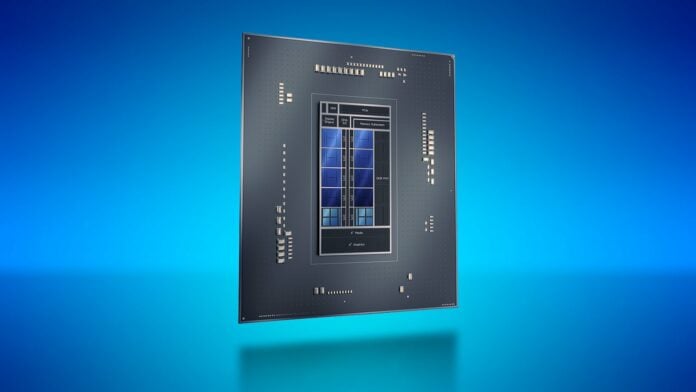Much has changed in the desktop PC landscape during the preceding week. Intel has come roaring back into the performance game with the release of 12th Gen Core chips known by the codename Alder Lake. Offering a mix of Performance and Efficient cores – the first time this has happened on desktop – the headline Core i9-12900K benchmarks well against AMD Ryzen competitors.
Yet for all Intel’s myriad advancements, comprising process, architecture, and implementation, the chip giant needs to run at elevated power budgets to dethrone AMD, and this is where comparing rival chips on an apples-to-apples basis becomes tricky. You see, Intel mandates a Processor Base Power (PBP) of 125W, which is close to the 105W prescribed by AMD. However, crucially, Intel also has a Maximum Turbo Power (MTP) of 241W for the same chip.
The MTP figure is the one enthusiast-orientated motherboards adopt naturally, with the premise being one of extracting the most performance out of the chip whilst still running within Intel-mandated specifications. Consider MTP to be automatic overclocking overtly encouraged by Team Blue.
Cranking up long-term power offers little scope for enhanced single-thread performance – running a few threads doesn’t tax the overall power budget by a discernible degree – but does mean Core i9-12900K benefits from running at higher multi-core speeds.
As we know how the chip reacts when operating at 241W, an interesting question is what level of performance is achieved if limiting power to 125W, which is what large OEMs such as Dell and HP are likely to do for their mainstream systems equipped with rudimentary cooling.

Thankfully it’s pretty straightforward to limit the chip’s total power to 125W. Intel’s useful XTU utility provides excellent control over various processor characteristics, including fine-grained power, as illustrated above. The application correctly identifies the reduced power limit as the key inhibitor of performance, and chip smarts dial down all-core frequency from around 4.8GHz to 4.3GHz, alongside lower voltage.
Exactly how the 125W limit affects performance is evaluated on an app-by-app basis, so without further ado, let’s run our Core i9-12900K in this more frugal power state and compare against previously tested chips.
Test Methodology
Intel Core comparisons
| Core i9-12900K | Core i9-11900K | Core i9-10900K | |
|---|---|---|---|
| Base clock | 3.2GHz | 3.5GHz | 3.7GHz |
| Turbo clock | 5.2GHz | 5.3GHz | 5.2GHz |
| L3 cache | 30MB | 16MB | 20MB |
| Cores / threads | 16 / 24 | 8 / 16 | 10 / 20 |
| TDP | 125W and 241W | 125W | 125W |
| Integrated GPU | UHD 770 | UHD 750 | UHD 630 |
| IGP base clock | – | 350MHz | 350MHz |
| IGP turbo clock | 1.55GHz | 1.30GHz | 1.20GHz |
| Socket | LGA 1700 | LGA 1200 | LGA 1200 |
| Lithography | 10nm | 14nm | 14nm |
| Motherboard | Asus ROG Maximus Z690 Hero | Asus ROG Maximus XIII Hero | Asus ROG Maximus XIII Hero |
| BIOS | 0702 | 0605 | 0605 |
| Memory | G.Skill Ripjaws S5 DDR5-4800 | G.Skill Trident Z DDR4-3200 | G.Skill Trident Z DDR4-3200 |
| Memory config | 2x16GB | 2x16GB | 2x16GB |
| Memory timings | 40-40-40-76 | 14-14-14-34 | 14-14-14-34 |
| Memory speed | 4,800MHz | 3,200MHz G1 | 2,933MHz |
| Storage | Corsair MP600 Pro XT NVMe 1TB | Corsair MP600 Pro XT NVMe 1TB | Corsair MP600 Pro XT NVMe 1TB |
| Power supply | be quiet Dark Power Pro 11 (1,000W) | be quiet Dark Power Pro 11 (1,000W) | be quiet Dark Power Pro 11 (1,000W) |
| Graphics card | Nvidia RTX 3080 FE | Nvidia RTX 3080 FE | Nvidia RTX 3080 FE |
| CPU cooler | Asus Ryujin II 360 | Noctua NH-D15S | Noctua NH-D15S |
| OS | Windows 10 | Windows 10 | Windows 10 |
AMD Ryzen comparisons
| Ryzen 9 5950X | Ryzen 7 5800X | Ryzen 9 3900XT | |
|---|---|---|---|
| Base clock | 3.4GHz | 3.8GHz | 3.8GHz |
| Turbo clock | 4.9GHz | 4.7GHz | 4.7GHz |
| L3 cache | 64MB | 32MB | 64MB |
| Cores / threads | 16 / 32 | 8 / 16 | 12 / 24 |
| TDP | 105W | 105W | 105W |
| Integrated GPU | – | – | – |
| IGP base clock | – | – | – |
| IGP turbo clock | – | – | – |
| Socket | AM4 | AM4 | AM4 |
| Lithography | 7nm | 7nm | 7nm |
| Motherboard | Asus X570 Crosshair VIII Hero WiFi | Asus X570 Crosshair VIII Hero WiFi | Asus X570 Crosshair VIII Hero WiFi |
| BIOS | 3801 | 3801 | 3801 |
| Memory | G.Skill Trident Z DDR4-3200 | G.Skill Trident Z DDR4-3200 | G.Skill Trident Z DDR4-3200 |
| Memory config | 2x16GB | 2x16GB | 2x16GB |
| Memory timings | 14-14-14-34 | 14-14-14-34 | 14-14-14-34 |
| Memory speed | 3,200MHz | 3,200MHz | 3,200MHz |
| Storage | Corsair MP600 Pro XT NVMe 1TB | Corsair MP600 Pro XT NVMe 1TB | Corsair MP600 Pro XT NVMe 1TB |
| Power supply | be quiet Dark Power Pro 11 (1,000W) | be quiet Dark Power Pro 11 (1,000W) | be quiet Dark Power Pro 11 (1,000W) |
| Graphics card | Nvidia RTX 3080 FE | Nvidia RTX 3080 FE | Nvidia RTX 3080 FE |
| CPU cooler | Noctua NH-D15S | Noctua NH-D15S | Noctua NH-D15S |
| OS | Windows 10 | Windows 10 | Windows 10 |
CPU Performance






Two truths emerge. As postulated, single-thread performance isn’t negatively impacted by any meaningful degree, evidenced by the near-identical scores in the 1T Cinebench and Geekbench tests. Running a few threads on either Performance or Efficient cores doesn’t get close to breaching a 125W limit, let alone 241W, so scaling overall power down is a sage move if most of the day-to-day work involves running simple applications.
By dropping package power by around 50 per cent we observe the chip manages to hold 85 per cent of the full-fat Cinebench performance, 87 per cent of all-core Keyshot, and 95 per cent of Geekbench, which is more lightly threaded.
It’s clear the optimal voltage/frequency curve for Alder Lake silicon is lower down the wattage spectrum and raising it to 241W is solely for combatting the best-in-class Ryzens.
Even so, single-thread performance remains first class for the 125W chip, while multi-thread is usually between Ryzen 9 5950X and Ryzen 9 3900XT.
There’s a strong case for using a 125W power budget if installing the Core i9-12900K into a small-form-factor PC or near-silent cooling is paramount.
Memory Performance




One shouldn’t expect memory bandwidth or latency to vary wildly when changing the power levels. That’s indeed the case, but it’s noteworthy the 241W chip remains marginally faster in each instance.






The core wars have been persisting for a while. AMD typically advances this argument in its favour. Having lots of cores carries value in megatasking scenarios, yet how many of us do six things at once? The prosaic truth is gaming and general work applications don’t mind running within a restrained power envelope.
Stands to reason, too, as both sets of applications are lightly threaded in nature. Look again at the gaming benchmarks to understand there’s very little difference between the Core i9-12900K being run in either 125W or 241W modes.
To understand why we must appreciate the application. The chip never approaches 241W in any game, so whether one installs a 125W, 190W or 241W limit, it’s all the same to the processor. We know this because system-wide power consumption when gaming changes by a only a handful of watts when in either state.
It follows that you don’t need 24 threads to game well, and this knowledge also presents compelling reasons to consider chips lower down the pecking order if fps is important. They are cheaper and ought to game just as well.


These are arguably the two most pertinent graphs for the reduced-power chip. Installing a 125W budget reduces the all-core-load power consumption by well over 100W when evaluated as a system.
It’s rare that desktop machines run on a 24/7 basis with such a load, but if that is the case, and you can accept the 10-15 per cent lower performance, there’s a 3kW daily saving to be made. No small change given escalating energy prices.
More pertinently for the enthusiast, lower wattage accurately transposes to lower temperatures and noise. The under-load figure drops from 73°C to just 54°C. Running at the same temperature, however, enables us to reduce the cooler’s fan noise by 6dB. Sure, you sacrifice some long-term oomph, yet we feel it’s a price worth paying for those who cherish quiet computing.
We’ve spoken at some length about the more efficient V/F curve at the lower end of the scale. There’s further proof in the energy-efficient chart, where system-wide power consumption is considered against the all-core Cinebench score. Going up by 33 per cent is no mean feat, of course, but AMD is still better in this regard.
Concluding Thoughts
Taking a look at the Intel Core i9-12900K when set to a maximum 125W budget is illuminating. Dialling down the juice to the base power levels shows very little performance is lost in light-load applications such as gaming and everyday office work. That makes intrinsic sense as the notional 241W Intel favours only comes into play when taxing every core and thread.
Limiting power is most keenly felt in tasks such as rendering. In these cases, performance drops by no more than 15 per cent, which puts the Core i9-12900K neatly between rival Ryzen 9 3900XT and 5950X in many cases. This indirectly tells us AMD’s process and architecture implementation remains excellent; there’s no need for AMD to panic as it remains attractive on performance as well as power.
Intel has driven the Alder Lake architecture hard on the Core i9 chips to be truly competitive. Our investigation suggests it ought to do better in power-restrained environments that play well with the V/F curve characteristics. Alder Lake is a fine CPU architecture at 241W, offers greater efficiency at 125W, but is primed to do finer things in laptops.
The Verdict: Unless you need absolute top-bin performance for rendering, there’s merit in limiting the Core i9-12900K to 125W, particularly if, like us, you enjoy cool and quiet computing.

